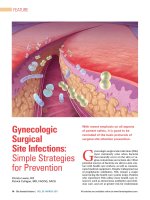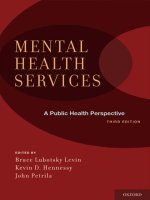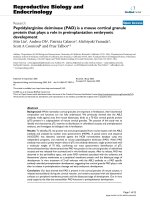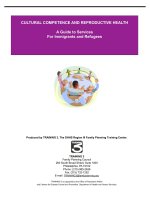A book about asthma for kids docx
Bạn đang xem bản rút gọn của tài liệu. Xem và tải ngay bản đầy đủ của tài liệu tại đây (2.54 MB, 16 trang )
Sponsored by an unrestricted
educational grant from
A book about asthma for kids.
For allergies to animals—
•
Do not keep animals that trigger
your symptoms in your home. If
you do, keep them out of rooms
where you spend a lot of time,
especially the bedroom.
•
Clean your home well and use a
HEPA filter to clean the air.
For allergies to cockroaches—
•
Frequently take out the trash and
don’t leave pet food out.
•
Seal openings where cockroaches
could enter, seal leaky pipes and
dry out your basement.
For allergies to indoor mold—
•
Dehumidify your home with air
conditioning and/or a room
dehumidifier.
•
Use a solution of 5% chlorine
bleach in water or a cleaning
agent with bleach to clean areas
where mold grows, such as the
shower.
For allergies to pollens and
outdoor molds—
•
In warmer months, keep windows
and doors closed and use air
conditioning to clean and dry the
air indoors.
•
Remove outdoor clothes and take
a shower after being outdoors on
high pollen and mold count days.
•
Dry clothes in a dryer rather than
hanging them outside where
pollen and mold can collect on
them.
For allergies to dust mites—
•
Wash all bedding frequently in hot
water and encase pillows and
mattresses with allergen-free,
zippered coverings.
•
Remove wall-to-wall carpeting,
stuffed animals, books and
upholstered furniture, especially
from the bedroom.
•
Dust mites love humidity, so keep
levels below 50% in your home.
In children, most asthma is allergic asthma. That means
many asthmatic children also have allergies and exposure
to those allergens to which your child is sensitized can
make his or her asthma symptoms worse. That’s why it’s
critical to understand what your child is allergic to and
how to best control his/her environment. Talk to your
allergist/immunologist for more information.
For caregivers of children with asthma
Also, to keep your child healthy make sure he or she regularly takes the
medication(s) prescribed by your doctor—even if symptoms are minimal.
The best asthma care is care that prevents worsening symptoms.
Sponsored by an unrestricted educational grant from
A book about asthma for kids.
Illustrations © 2000, Susan Tolonen.
© 2000, American Academy of Allergy, Asthma
and Immunology. All rights reserved.
May not be duplicated or appropriated
without permission.
Achoo! Achoo! Achoo!” Tonya let out a long string
of coughs and sneezes. Tonya reached for a tissue, but
the
box
fell
down.
“Would you pick it up, Mommy? I’m too tired to get
out of bed.”
Last night, Tonya spent more hours coughing than
sleeping.
“Tonya, I think you need to see the doctor.”
Tonya liked Dr. Burton. He had seen Tonya since she
was a baby, and he always had the best pencils.
“
Honey, Dr. Burton wants you to see a special
doctor called an allergist. Her name is Dr. Watkins.
She can find out why you cough so much and why your
chest hurts.”
At night, even when she didn’t have a cold, Tonya’s
chest felt heavy.
“Maybe while I’m asleep my stuffed giraffe falls on
me,” she imagined. Tonya’s best friend, Angela, had
given her the giraffe.
Tonya really hoped she would be well enough to go.
Tonya had missed Megan’s bowling party. She had
missed trick-or-treating, too.
“Being sick and missing out on fun makes you sad,
doesn’t it?” Tonya’s mother asked.
Tonya nodded her head and took another tissue. This
time she used it for her eyes, not her nose.
Dr. Watkins, the allergist, turned out to be as nice
as Dr. Burton. “I want to find out more about your
airways and how they’re moving air in and out,”
she said.
Dr. Watkins listened to Tonya’s chest. She said,
“I’m going to ask you to breathe into this
hose. It’s connected to a machine called
a spirometer, which can tell us
things about your breathing that
we can’t see.”
Tonya breathed into the hose
and watched the screen. It
was like TV, but it showed
her breathing!
“
Tonya, you have asthma,” said Dr. Watkins.
“Asthma is a condition that makes it hard for you to
breathe. Asthma is what is making you cough a lot at
night, and it makes your chest hurt and feel tight,” she
told Tonya. “You didn’t do anything wrong to get
asthma—lots of kids have it. But we can help you feel
much better.”
“We all have a job to do. First, my job is to find out
what triggers your asthma.”
Dr. Watkins told Tonya that the nurse would scratch
Tonya’s arm with tiny needles. “They’ll feel like tiny
itches, not shots,” Dr. Watkins assured Tonya. “And
after the nurse finishes, you can pick out a dinosaur
pencil.”
After the test, Dr. Watkins said, “Well, Tonya, I can
tell by looking at the bumps on your arms that lots of
things trigger your asthma. Some things in the air are
causing problems when you breathe them in. They
probably make you sneeze, too.”
“
These things are called allergens. So, I have
another job—to give you allergy medicine
that protects you against allergens.”
“You have some jobs, too, Tonya.
First, you need to carry and use an
inhaler. The nurse will show you
how to use it. You’re a smart
girl, so you’ll learn fast. Then
you can use it all by yourself.”
“
An inhaler holds medicine that will help you
breathe better and feel well. Your chest won’t hurt as
much or so often. You won’t cough as much, either.
Remember, you need to keep it with you, all the time.”
“I can carry it in my backpack,” Tonya said. “Right,”
Dr. Watkins said.
“Your parents’ job is to help you think of ways to make
sure you have it with you all the time. And they can
help get rid of allergens in your house by cleaning and
taking other measures.”
“
Another of your jobs is to stay away
from dogs. You’re allergic to them, so
they make it hard for you to breathe.”
Dr. Watkins showed Tonya a peak flow
meter. “This looks like a kazoo, doesn’t it,
Tonya? You can use this every day to see how well you
are breathing. The nurse will teach you how.”
“
At home, your parents can help you use it and chart
your readings. To keep Tonya well, we all have jobs to
do,” Dr. Watkins said. “But we don’t need prizes for
doing our jobs right. All we need is a healthy girl.”
555 East Wells Street, Suite 1100
Milwaukee, WI 53202-3823
Phone: (414) 272-6071 Fax: (414) 272-6070
E-mail:
Web site: www.aaaai.org
Sponsored by an unrestricted education grant from
For more asthma information for kids, visit the
Kids’ Page on www.aaaai.org.
(There’s lots of information for parents, too.)









